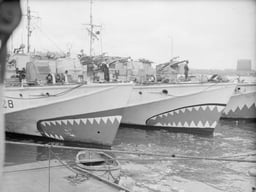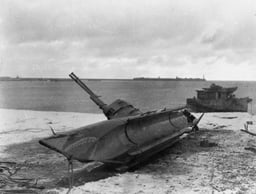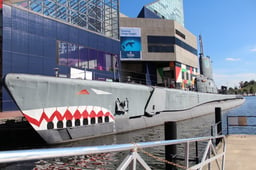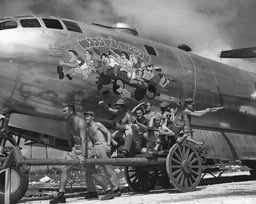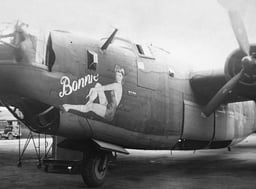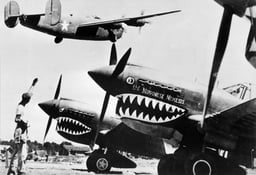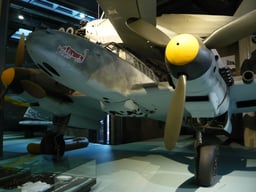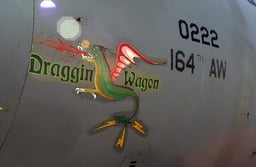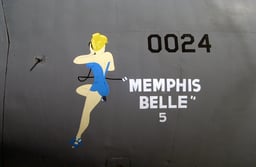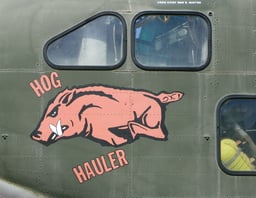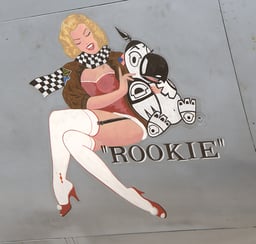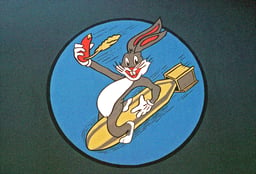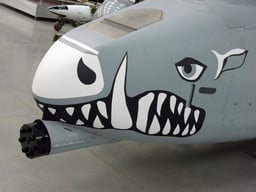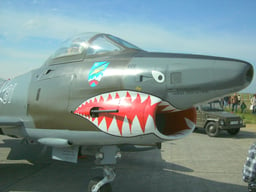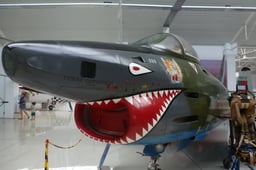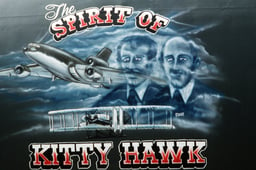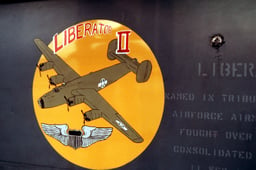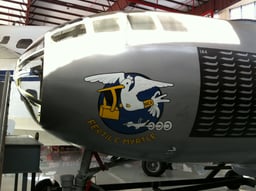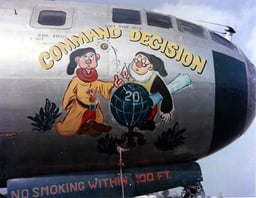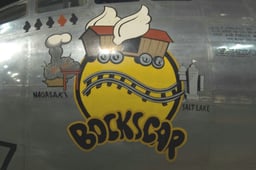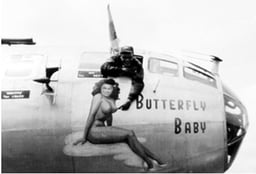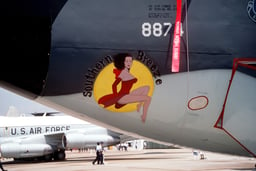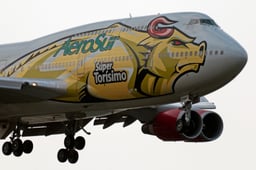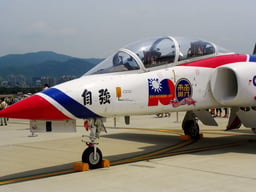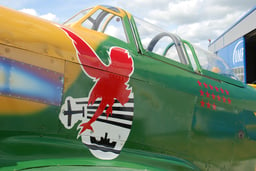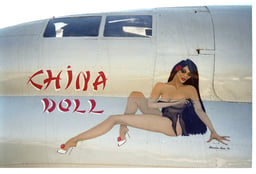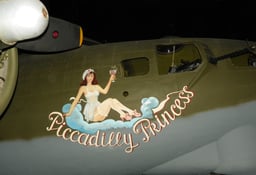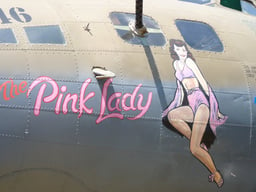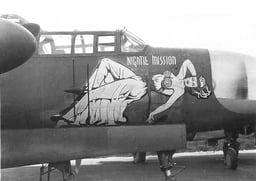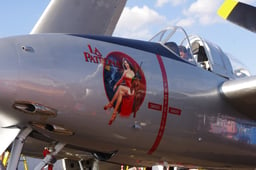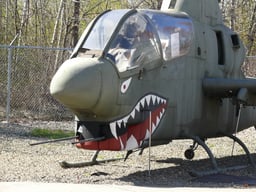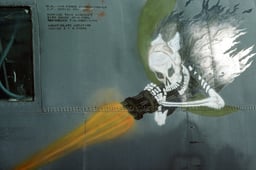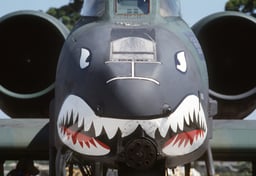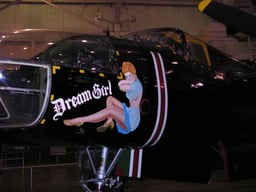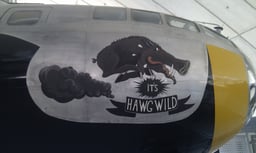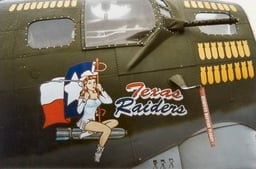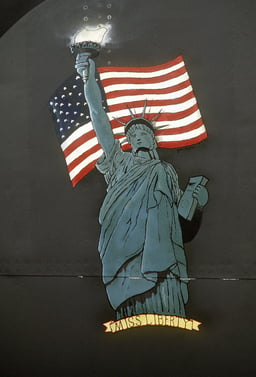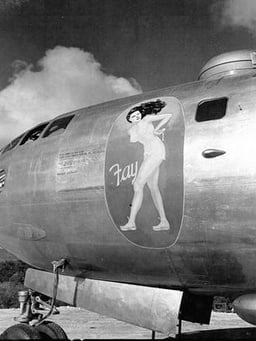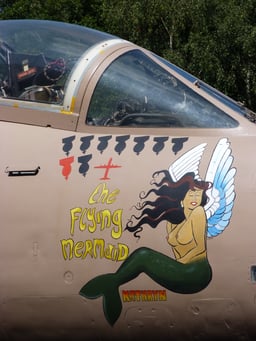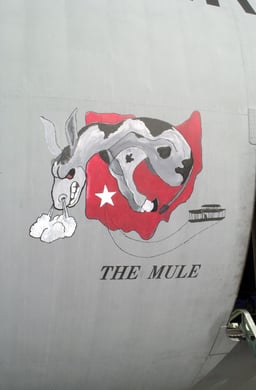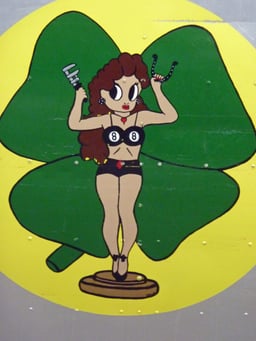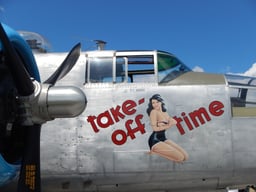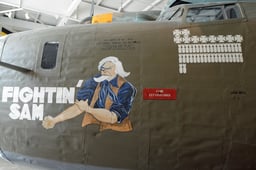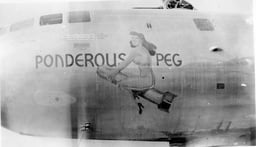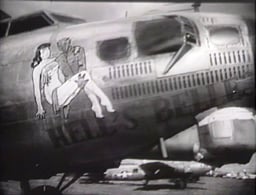Nose art

Nose art

Virgin Atlantic A340-600 G-VGAS nose art
While begun for practical reasons of identifying friendly units, the practice evolved to express the individuality often constrained by the uniformity of the military, to evoke memories of home and peacetime life, and as a kind of psychological protection against the stresses of war and the probability of death. The appeal, in part, came from nose art not being officially approved, even when the regulations against it were not enforced.[1][2]
Because of its individual and unofficial nature, it is considered folk art, inseparable from work as well as representative of a group.[1] It can also be compared to sophisticated graffiti. In both cases, the artist is often anonymous, and the art itself is ephemeral. In addition, it relies on materials immediately available.[1]
Nose art is largely a military tradition, but civilian airliners operated by the Virgin Group feature "Virgin Girls" on the nose as part of their livery. In a broad sense, the tail art of several airlines such as the Eskimo of Alaska Airlines can be called "nose art", as are the tail markings of present-day U.S. Navy squadrons. There were exceptions, including the VIII Bomber Command, 301st Bomb Group B-17F "Whizzer", which had its girl-riding-a-bomb on the dorsal fin.[3]
History
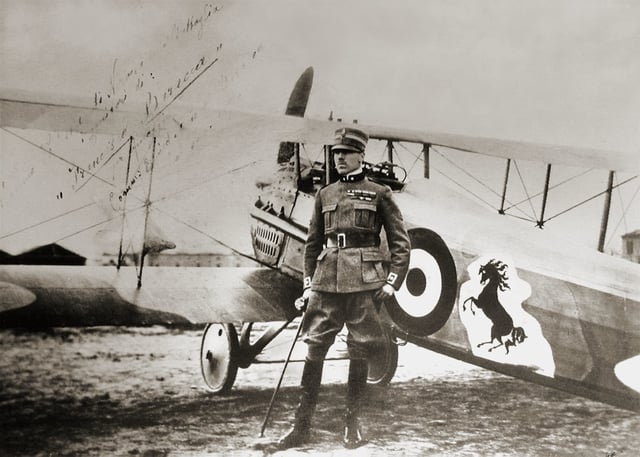
Count Francesco Baracca and his SPAD S.VII, with the cavallino rampante that inspired the Ferrari emblem

Eddie Rickenbacker with SPAD XIII (note the "Hat in the Ring" 94th Aero Squadron insignia), France, 1918

Spad XIII pursuit aircraft of the 95th Aero Squadron with the "Kicking Mule" insignia, France, 1918
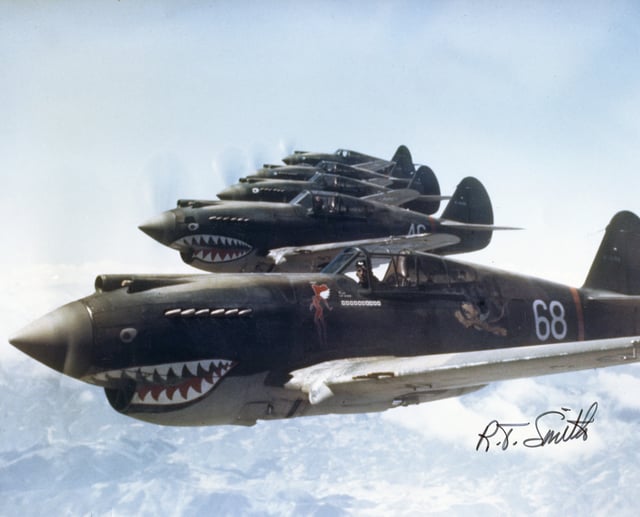
Hell's Angels, the 3rd Squadron of the 1st American Volunteer Group "Flying Tigers", 28 May 1942

A-10 Thunderbolt II with shark mouth themed nose art, Kandahar Airfield, Afghanistan, 2011

The "Dragon and His Tail" nose art on a B-24 Liberator, Moffett Field, 2004 – from 2005-on, Witchcraft (s/n 44-44052)

Sgt. J.S. Wilson painting a bomber based at Eniwetok in June 1944

Boeing KC-135E Stratotanker, based with Sioux City Air National Guard, 2007.
Placing personalized decorations on fighting aircraft began with Italian and German pilots. The first recorded example was a sea monster painted on an Italian flying boat in 1913. This was followed by the popular practice of painting a mouth beneath the propeller's spinner, begun by German pilots in World War I. What is perhaps the most famous of all nose art, the shark-face insignia later made famous by the First American Volunteer Group (AVG) Flying Tigers, first appeared in World War I on a British Sopwith Dolphin and a German Roland C.II, though often with an effect more comical than menacing.[4] The cavallino rampante (prancing horse) of the Italian ace Francesco Baracca was another well-known image.
World War I nose art was usually embellished or extravagant squadron insignia. This followed the official policy established by the American Expeditionary Forces' Chief of the Air Service, Brigadier General Benjamin Foulois, on 6 May 1918, requiring the creation of distinct, readily identifiable squadron insignia.[5] World War I examples include the "Hat in the Ring" of the American 94th Aero Squadron (attributed to Lt. Johnny Wentworth)[5] and the "Kicking Mule" of the 95th Aero Squadron. Nose art of that era was often conceived and produced not by the pilots, but rather by ground crews.
True nose art appeared during World War II, which is considered by many observers to be the golden age of the genre, with both Axis and Allied pilots taking part. At the height of the war, nose artists were in very high demand in the USAAF and were paid quite well for their services, while AAF commanders tolerated nose art in an effort to boost aircrew morale. (The U.S. Navy, by contrast, prohibited nose art, the most extravagant being limited to a few simply-lettered names, while nose art was uncommon in the RAF and RCAF.) The work was done by professional civilian artists as well as talented amateur servicemen. In 1941, for instance, the 39th Pursuit Squadron commissioned a Bell Aircraft artist to design and paint the "Cobra in the Clouds" logo on their aircraft.[6]
Perhaps the most enduring nose art of World War II was the shark-face motif, which first appeared on the Bf 110s of Luftwaffe 76th Destroyer Wing over Crete, where the twin-engined Messerschmitts outmatched the Gloster Gladiator biplanes of RAF 112 Squadron. The Commonwealth pilots were withdrawn to Egypt and refitted with Curtiss Tomahawks off the same assembly line building fighter aircraft for the American Volunteer Group (AVG) Flying Tigers being recruited for service in China. In November 1941, AVG pilots saw a color photo in a newspaper of a shark mouth painted on a No. 112 Squadron RAF P-40 fighter in North Africa and immediately adopted the shark-face motif for their own P-40Bs.[7] The British version itself was inspired by "sharkmouth" nose art (without any eyes) on the Bf 110 heavy fighters of ZG 76. This work was done by the pilots and ground crew in the field.[8] However, the insignia for the "Flying Tigers" – a winged Bengal Tiger jumping through a stylized V for Victory symbol – was developed by graphic artists from the Walt Disney Company.[9]
Similarly, when in 1943 the 39th Fighter Squadron became the first American squadron in their theatre with 100 kills, they adopted the shark-face for their P-38 Lightnings.[6] The shark-face is still used to this day, most commonly seen on the A-10 Thunderbolt II (with its gaping maw leading up to the muzzle of the aircraft's GAU-8 Avenger 30mm cannon), especially those of the 23d Fighter Group, the AVG's descendent unit, and a testament to its popularity as a form of nose art.
The largest known work of nose art ever depicted on a World War II-era American combat aircraft was on a B-24J Liberator, tail number 44-40973, which had been named "The Dragon and his Tail" of the USAAF Fifth Air Force 64th Bomb Squadron, 43d Bomb Group, in the Southwest Pacific, flown by a crew led by Joseph Pagoni, with Staff Sergeant Sarkis Bartigan as the artist. The dragon artwork ran from the nose just forward of the cockpit, down the entire length of the fuselage's sides, with the dragon's body depicted directly below and just aft of the cockpit, with the dragon holding a nude woman in its forefeet.[10][11]
Tony Starcer was the resident artist for the 91st Bomb Group (Heavy), one of the initial six groups fielded by the Eighth Air Force. Starcer painted over a hundred pieces of renowned B-17 nose art, including "Memphis Belle".[12][13] A commercial artist named Brinkman, from Chicago was responsible for the zodiac-themed nose art of the B-24 Liberator-equipped 834th Bomb Squadron, based at RAF Sudbury, England.[14]
Contemporary research demonstrates that bomber crews, who suffered high casualty rates during World War II, often developed strong bonds with the planes they were flying, and affectionately decorated them with nose art.[15] It was also believed by the flight crews that the nose art was bringing luck to the planes.[16]
The artistic work of Alberto Vargas's pin-up girls from Esquire Magazine was often duplicated, or adapted, by air force crews and painted on the nose of American and allied aircraft during World War II.
Some nose art was commemorative or intended to honor certain people, such as the B-29 Superfortress "The Ernie Pyle".[17]
In the Korean War, nose art was popular with units operating A-26 and B-29 bombers, C-119 Flying Boxcar transports, as well as USAF fighter-bombers.[18] Due to changes in military policies and changing attitudes toward the representation of women, the amount of nose art declined after the Korean War.
During the Vietnam War, AC-130 gunships of the U.S. Air Force Special Operations Squadrons were often given names with accompanying nose art – for example, "Thor", "Azrael – Angel of Death", "Ghost Rider", "War Lord" and "The Arbitrator." [19] The unofficial gunship badge of a flying skeleton with a Minigun was also applied to many aircraft until the end of the war and was later adopted officially.
Nose art underwent a revival during the Gulf War and has become more common since Operation Enduring Freedom and the Iraq War began. Many crews are merging artwork as part of camouflage patterns. The United States Air Force had unofficially sanctioned the return of the pin-up (albeit fully clothed) with the Strategic Air Command permitting nose art on its bomber force in the Command's last years. The continuation of historic names such as "Memphis Belle" was encouraged.
Regional variation

"Sharkmouth" Bf 110C of ZG 76, May 1940
Source material for American nose art was varied, ranging from pinups such as Rita Hayworth and Betty Grable and cartoon characters such as Donald Duck, Bugs Bunny, and Popeye to patriotic characters (Yankee Doodle) and fictional heroes (Sam Spade). Lucky symbols such as dice and playing cards also inspired nose art, along with references to mortality such as the Grim Reaper.[1] Cartoons and pinups were most popular among American artists, but other works included animals, nicknames, hometowns, and popular song and movie titles. Some nose art and slogans imposed contempt to the enemy, especially to enemy leaders.
Luftwaffe aircraft did not often display nose art, but there were exceptions.[21] For example, Mickey Mouse adorned a Condor Legion Bf-109 during the Spanish Civil War and one Ju 87A was decorated with a large pig inside a white circle during the same period. Adolf Galland's Bf-109E-3 of JG 26 also had a depiction of Mickey Mouse, holding a contemporary telephone in his hands, in mid-1941. A Ju 87B-1 (Geschwaderkennung of S2+AC) of Stab II/St. G 77, piloted by Major Alfons Orthofer and based in Breslau-Schöngarten (today Copernicus Airport Wrocław) during the invasion of Poland, was painted with a shark's mouth, and some Bf 110s were decorated with furious wolf's heads, stylistic wasps (as with SKG 210 and ZG 1), or as in the case of ZG 76, the very shark mouths that inspired both the RAF's 112 Squadron and in turn the Flying Tigers in China, on their noses or engine covers. Another example was Erich Hartmann's Bf-109G-14, "Lumpi", with an eagle's head. The fighter wing Jagdgeschwader 54 was known as the Grünherz (Green Hearts) after their fuselage emblem, a large green heart. The Geschwader was originally formed in Thüringen, nicknamed "the green heart of Germany". Perhaps the flashiest Luftwaffe nose art was the red and white viper snake insignia running through the whole fuselage of certain Ju 87 Stukas that served with the II Gruppe, and especially the 6. Staffel of StG 2 in North Africa, the only known artwork on an Axis-flown combat aircraft that could have rivaled the length of that on "The Dragon and his Tail" B-24. front portside view [34] entire portside [35] ground view [36] .
The Soviet Air Force also decorated their planes with historical images, mythical beasts, and patriotic slogans.
The attitude of the Finnish Air Force to the nose art varied by unit. Some units disallowed nose art, while others tolerated it. Generally, the Finnish airforce nose art was humorous or satirical, such as the "horned Stalin" on Maj. Maunula's Curtiss P-36.
The Japan Air Self-Defense Force has decorated fighter aircraft with Valkyrie-themed characters under the names Mystic Eagle and Shooting Eagle.[22]
Beginning in 2011, the Japan Ground Self-Defense Force has AH-1S Cobra anti-tank helicopters and Kawasaki OH-1 observation helicopter named Ita-Cobra and Ita-Omega respectively, decorated in the theme of 4 Kisarazu (木更津) sisters (Akane (木更津茜), Aoi (木更津葵), Wakana (木更津若菜), Yuzu (木更津柚子)).[23] The Aoi-chan first appeared in 2011, followed by the other three sisters in 2012.[24][25]
Canadian Forces were reported having nose art on CH-47D Chinook and CH-146 Griffon helicopters in Afghanistan.[26]
Famous examples
Adolf Galland was famous for painting Mickey Mouse on his aircraft, and the mascot was adopted by his Gruppe during the early airwar phase of World War II.
Werner Mölders flew a yellow-nosed Bf 109F-2 while with JG 51 during June 1941.
Other fighter aces and their nose art have become synonymous.
Don Gentile's P-51C named "Shangri-La", with an eagle sporting boxing gloves.
John D. Landers' P-51D, which sported a distinctive black-and-white checkerboard with red trim.
Chuck Yeager's series of aircraft named "Glamorous Glennis", with bright letter art.
Ian Gleed's Hurricanes and Spitfires featured Figaro the Cat, from the 1940 Disney animated movie Pinocchio.
Pierre Clostermann's Hawker Tempest Le Grand Charles featured the Cross of Lorraine.
Johnny Johnson's Spitfire IX featured the Canadian maple leaf.
Erich Hartmann's Bf 109s featured a distinctive "black tulip" design on the very front of the cowling, immediately behind the spinner.
James MacLachlan, who flew with an artificial arm, had his Hawker Hurricane adorned with a picture of his amputated arm giving a V sign
Brendan Finucane's Spitfires wore a shamrock with a "B" within it. Ireland's top ace in World War Two who also was the youngest wing commander in Royal Air Force history.
The markings of aces were often adopted by their squadrons, such as Galland's Mickey Mouse and Hartmann's black tulip (still in use until recently on the aircraft of JG 71 "Richthofen" – not known to be in use on the unit's new Eurofighter Typhoons).
Ted W. Lawson, who (along with journalist Bob Considine) famously wrote about the 1942 Doolittle Raid in Thirty Seconds Over Tokyo, piloted a B-25 Mitchell bomber nicknamed The Ruptured Duck, after a minor training accident in which the aircraft tail scraped the ground during takeoff; this was decorated by a caricature of an angry Donald Duck figure with crutches and wearing a pilot's headphones.
Similar art
Designs similar to aviation nose art could be found during World War II on some British torpedo boats, and German and US submarines.
Bans
The British MoD banned the use of pin-up women in nose art on Royal Air Force aircraft in 2007, as commanders decided the images (many containing naked women), were inappropriate and potentially offensive to female personnel, although there were no documented complaints.[27]
In 1993 the United States Air Force Air Mobility Command ordered that all nose art should be gender-neutral.[28]



